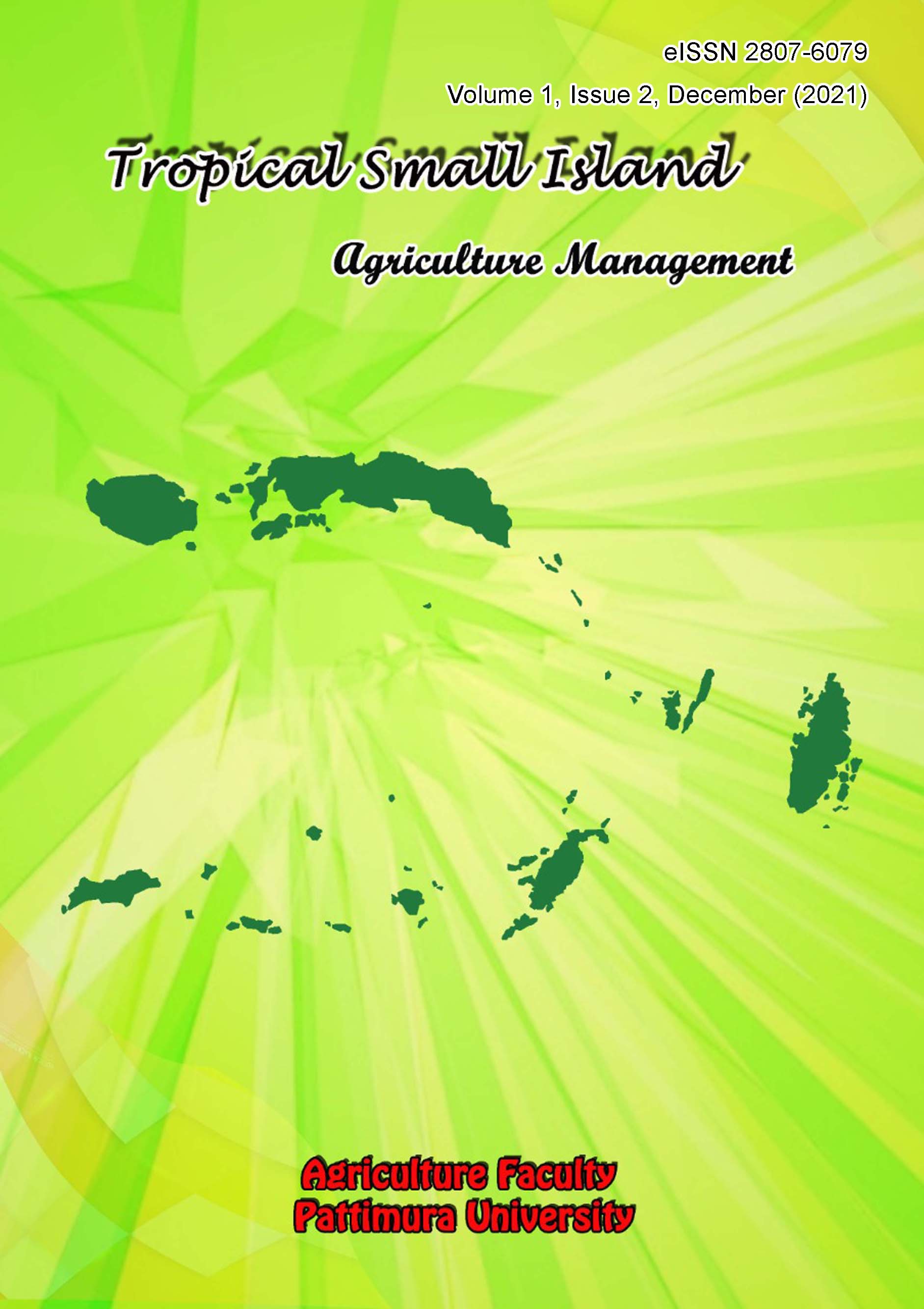Karakteristik Fisikokimia dan Organoleptik Gula Merah Cair Asal Pulau Kisar Provinsi Maluku
Physicochemical and Organoleptic Characteristics of Liquid Brown Sugar from Kisar Island Maluku Province
Abstract
This study aims to determine the best ratio of brown sugar to water in making liquid brown sugar based on its physicochemical and organoleptic properties. This study was designed using a completely randomized design (CRD). The ratio of brown sugar to water consists of 4 treatment levels: 1:1, 1:2, 1:3, and 1:4. The results showed that the brown sugar “water treatment of 1:1 is the best treatment with physicochemical characteristics such as moisture content of 48.29%, total sugar of 50.94%, total dissolved solids of 52.3, and pH of 5.3. Based on hedonic organoleptic characteristics for color 3.28 (like), aroma 3.44 (like), viscosity 2.8 (rather like), taste 3.52 (like), overall 3.52 (like), and for quality organoleptic characteristics hedonic, namely color 3.72 (brownish), aroma 3.48 (fragrant), viscosity 3.0 (thick), taste 3.44 (sweet) and overall 3.52 (like).
Downloads
References
Anova, I.T & Kamsina, K. (2012). Pengaruh substitusi tepung tapioka dengan beberapa jenis tepung terhadap mutu makanan mpek-mpek Palembang. Jurnal Litbang Industri Balai Riset dan Standardisasi Industri Padang, 2, 27-33
AOAC. (2005). Official Methods of Analysis Association of Official Analytical Chemist. Inc. Arlington Virginia
Assah, Y. F., & Indriaty, F. (2018). Pengaruh lama penyimpanan terhadap mutu gula cair dari nira aren. Jurnal Penelitian Teknologi Industri, 10(1), 1.
Ayu, D.M. (2019). Kadar Alkohol Pada Nira Siwalan (Borassus flabellifer) dengan Penambahan Extrak Jahe Merah (Zingber officinale Var. Rubrum). Diploma Thesis, Stikes Insan Cendekia Medika Jombang.
Diniyah, N., Wijanarko, S.B., & Purnomo, H. (2012). Teknologi pengolahan gula cokelat cair nira siwalan (Borassus flabellifera L.). Jurnal Teknologi dan Industri Pangan, 23(1), 53-57.
Harun, N. Efendi, R & Simanjuntak, L. (2014). Penerimaan panelis terhadap teh herbal dari kulit buah manggis (Garcinia mangostana L.) dengan perlakuan suhu pengeringan. Sagu, 13, 7-18.
Heryani, H. (2016). Keutamaan Gula Aren dan Strategi Pengembangan Produk. Cetakan Pertama. Lambung Mangkurat University Press. Kayu Tangi Banjarmasin. 132p.
Hasanah, S.Z. (2017). Pengaruh Perbandingan Gula Merah Cair dan Nira Terhadap Karakteristik Gula Semut (Palm Sugar). Skripsi. Bandung: Universitas Pasudan Bandung
Lamusu, D. (2018). Uji organoleptik jalangkote ubi jalar ungu (Ipomoea batatas L.) sebagai upaya diversifikasi pangan. Jurnal Pengolahan Pangan, 3, 9-15.
Lempang, M. (2012). Pohon aren dan manfaat produksinnya. Info Teknis EBONI, 9, 48-49.
Lastriyanto, A & Aulia, A.I. (2021). Analisa kualitas madu singkong (gula pereduksi, kadar air, dan total padatan terlarut) pasca proses pengolahan dengan vacuum cooling. Jurnal Ilmu Produksi dan Teknologi Hasil Peternakan, 9, 110-114.
Osman, O.A & Sulieman, A.M.E. (2023). Halal and Kosher Food. Switzerland: Springer Cham.
Saragih, C.H, Netti & Efendi. R. (2017). Pembuatan sirup ubi jalar ungu (Ipomea batatas L.) dengan penambahan sari lemon (Citrus limon L.). Jurnal Online Mahasiswa, 4, 1-15.
Sukoyo, A. Argo, B.D & Yulianingsih, R. (2014). Analisis pengaruh suhu pengolahan dan derajat Brix terhadap karakteristik fisikokimia dan sensoris gula kelapa cair dengan metode pengolahan vakum. Jurnal Bioproses Komoditas Tropis, 2, 170-179.
Togatorop, D.M. (2015). Pengaruh Perbandingan Sari Batang Sereh dengan Sari Jahe dan Konsentrasi Serbuk Gula Aren Terhadap Mutu Serbuk Minuman Penyegar Sereh. Skrpsi. Departemen Teknologi Pangan. Fakultas Pertanian USU Medan.
Ulaan, L.E., Ludong, M.M., Rawung, D. & Langi, T. M. (2015). Pengaruh perbandingan jenis gula aren (Arenga pinnata Merr) terhadap mutu sensoris halua kacang tanah (Arachis hypogeae L.). Cocos, 6, 1-9.
Copyright (c) 2023 The Author(s)

This work is licensed under a Creative Commons Attribution-ShareAlike 4.0 International License.
Authors who publish with this journal agree to the following terms:
- Authors retain copyright and grant the journal right of first publication with the work simultaneously licensed under a Creative Commons Attribution License that allows others to share the work with an acknowledgment of the work's authorship and initial publication in this journal.
- Authors are able to enter into separate, additional contractual arrangements for the non-exclusive distribution of the journal's published version of the work (e.g., post it to an institutional repository or publish it in a book), with an acknowledgment of its initial publication in this journal.
- Authors are permitted and encouraged to post their work online (e.g., in institutional repositories or on their website) prior to and during the submission process, as it can lead to productive exchanges, as well as earlier and greater citation of published work (See The Effect of Open Access).









